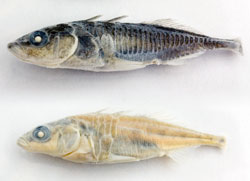January 8, 2008 - By Amy Adams

Ocean sticklebacks are dark-colored fish that often migrate. Some have evolved lighter gill and skin colors after colonizing new lakes and streams. Above are ocean (upper) and freshwater creek (lower) sticklebacks.
When waves of people left Africa roughly 50,000 years ago and spread across Europe and Asia, they developed lighter skin color to adapt to lower levels of sunlight. Now researchers at the School of Medicine have found the gene responsible for that change, adding that it also explains how groups of light-colored fish evolved from darker fish.
This finding adds another layer of support to the idea that evolutionary change can occur through the same mechanism even in very different animals.
David Kingsley, PhD, professor of developmental biology and senior author of the study, said evolutionary biologists have long debated exactly how evolution progresses. Some have argued that many mutations accumulate like tiny drops of dye added to paint that, after thousands of drops, eventually lead to a noticeable color change. Others think that mutations in important genes act like a large dollop of pigment, changing the paint color - or the organism's appearance - in a fell swoop.
Kingsley's findings add support to the genetic dollop theory.
'It's exciting that what we've learned before about evolution reusing the same general mechanisms also applies to our own evolutionary past,' said Kingsley, who is also an investigator of the Howard Hughes Medical Institute.
This work, which was published in the Dec. 14 issue of the journal Cell, marks the third time Kingsley has found that a single gene had been used repeatedly in different populations to produce similar evolutionary change. Each of these findings came about through studying a finger-length fish called the threespine stickleback.
Although the small fish may seem far removed from our own evolutionary past, Kingsley said the two groups share many similarities. Both migrated out of their ancestral environments to new locations a few thousand generations ago. Both emigrant populations adapted traits, such as skin color changes, to live successfully in those new locations.
In the case of sticklebacks, some of the original oceanic fish ended up in lakes or streams where the original darker color might have helped them hide from predators. Others wound their way into new homes where losing the darker color was an advantage.
Kingsley and his co-workers compared the DNA of lighter fish and darker fish in search of genetic changes that could account for the lighter color. What they found is that each of the lighter fish populations had mutations in a gene called Kit ligand.
Knowing that people had also adapted lighter skin when they migrated north, Kingsley wondered whether mutations in the same gene accounted for light pigmentation in people living in northern climes. In the north, where less sunlight reaches the ground, lighter coloring helps people absorb enough sunlight to produce vitamin D.
Kingsley and his colleagues collected DNA from people with a variety of skin colors to look for alterations in the Kit ligand gene. Sure enough, people with lighter skin had an altered form of the gene. He said this gene isn't alone in controlling a person's skin color, but it does seem to account for about 20 percent of the differences in pigmentation between people of African and northern European descent.
'It is the same genetic mechanism between organisms that are very different from each other,' Kingsley said. This gene is known to make a protein that plays a role in maintaining the melanocyte skin cells that control pigmentation.
In terms of how evolution progresses, this gene would be a large ladle of dye that helps set the paint color apart from the original. Additional genetic changes account for the exact color of each person's skin.
The work was funded by the Jane Coffin Childs Memorial Fund, the Portuguese Foundation for Science and Technology, the Natural Sciences and Engineering Research Council of Canada, the Canada Foundation for Innovation and the National Institutes of Health.
Other Stanford researchers who contributed to this work include postdoctoral scholar Craig Miller, PhD, and graduate student Alex Pollen.
About Stanford Medicine
Stanford Medicine is an integrated academic health system comprising the Stanford School of Medicine and adult and pediatric health care delivery systems. Together, they harness the full potential of biomedicine through collaborative research, education and clinical care for patients. For more information, please visit med.stanford.edu.